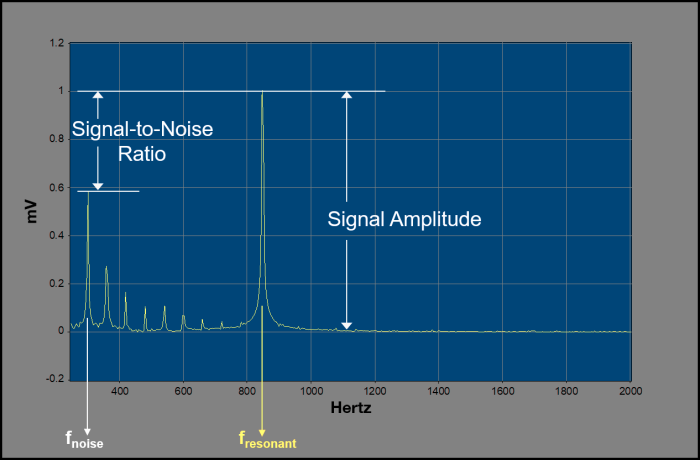VSPECT®を 最大限に活用する
by Jacqalyn Maughan | 更新日: 08/22/2023 | コメント: 3

VSPECT®の利点を理解することで、この技術を最大限に活用できるようになります。この記事では、このトピックについて詳しく解説し、より良い測定体験をご提供します。
Campbell Scientific の監視プラットフォームが追加のバイブレーティングワイヤーデータを提供するのはなぜですか?
弊社のVSPECTモニタリングプラットフォーム( CR6、CRVW3、AVW200、VWAnalyzer、またはGranite™ VWire 305 )をご利用になったことはありますか?
これらのプラットフォームを使用して振動ワイヤセンサーを測定していた際、「他社製品のように2つのデータポイントではなく、なぜ6つのデータポイントが表示されるのか」と疑問に思われたかもしれません。ご安心ください!今回は、各データポイントについて詳しく説明し、VSPECTからセンサーについて何がわかるのかを解説します。
これらの製品をまだ使用したことがない場合は、この記事を読むことで VSPECT の利点を理解し、当社の製品とテクノロジーの使用を検討する際に十分な情報に基づいた決定を下すことができます。
サーミスタ抵抗とセンサー周波数
まず、サーミスタ抵抗とセンサー周波数を見てみましょう。これらは、あらゆるデータ収集システムで得られる2つのデータポイントです。
サーミスタ抵抗に関しては、温度に変換してデータ ポイントとして使用したり、バイブレーティングワイヤーセンサーの温度変化を補正したりすることができます。
さて、最も重要なデータポイントであるセンサー周波数を見てみましょう。これは工学単位(圧力、ひずみ、荷重など)に変換され、センサーを取り巻く環境の変化を測定することができます。
VSPECT対応のモニタリングプラットフォームは、単に周波数を読み取るだけではありません。VSPECTはセンサー周波数を読み取り、センサー信号内の競合する周波数から分離することで、最も正確な測定を実現します。VSPECTを使用することで、電力線、近くの重機、水力発電所などの電気干渉源を除去することで、可能な限り再現性の高いデータを取得できます。
センサー振幅
センサー振幅とは?これは、バイブレーティングワイヤーセンサーのミリボルト応答の二乗平均平方根(つまりセンサー応答の強さ)の測定値です。このデータポイントをセンサーの寿命期間中記録することで、センサーの相対的な健全性に関する概要を把握できます。
例えば、周波数データが不安定であることに気づき、環境がそれほど大きく変化することはあり得ないとわかっている場合などです。センサーを設置した日から今日までのセンサー振幅データをプロットすると、振幅が劇的に減少していることに気づきます。これは、何らかの要因がセンサーの信号強度に影響を与えており、さらなる調査が必要であることを示しています。
ノイズ周波数と信号対雑音比
ノイズ周波数とは、監視プラットフォームが読み取るセンサー信号に影響を与える最も高い電気ノイズ周波数(干渉とも呼ばれます)の振幅のことです。これは、送電線、近くの採掘設備、水力発電所などからの60Hzの干渉が考えられます。また、センサー周波数の整数倍で発生する高調波が原因となる場合もあります。このデータを保存しておくと、センサー測定に影響を与えている干渉源を特定するのに役立ちます。
次に、信号対雑音比(S/N比)を見てみましょう。これは、センサー周波数とノイズ周波数の比です。これは、センサー周囲の電気ノイズが測定にどの程度影響を与えているかを示します。数値が高いほど、ノイズがセンサー信号に与える影響は小さく、数値が小さいほど影響が大きいことを示します。VSPECTは干渉を分離して除去するため、たとえ大きな干渉があっても測定に影響はありません。ただし、他社のモニタリングプラットフォームでは、精度に影響が出る可能性があります。
減衰率
減衰比とは、VSPECTで測定されるバイブレーティングワイヤーセンサーの「リングダウン」のことです。減衰比を時間経過に沿ってプロットすることで、設置後のセンサー環境やセンサー特性の変化を把握できます。これは、センサーの健全性を示すもう一つの指標です。
大きな注意点
このトピックについて議論する際には、覚えておいていただきたい重要な点があります。どのセンサーにおいても、「健全」とみなされる数値や閾値は存在しません。これは、バイブレーティングワイヤーセンサーのメーカーと種類によって異なります。メーカーごとに特性が異なります。つまり、センサーの振幅、信号対雑音比、減衰比など、センサーが正常に機能しているかどうかを判断するための正確な数値や閾値を提示することはできません。しかし、ご安心ください。センサーの検証に役立つデータをご提供し、お客様が自信を持って結果にご満足いただけるよう努めています。
VSPECTを最大限に活用する
当社の VSPECT 対応モニタリング プラットフォーム (CR6、CRVW3、AVW200、VWAnalyzer、および VWire 305) についてお客様にお話しすると、センサーの健全性を確認するために使用されるデータがすでに取得されていることに気付いていないお客様が多くいらっしゃいます。
Campbell Scientific では、あらゆるプロジェクトを成功させるためのツールを提供しており、時の試練に耐えられる長期プロジェクトに携われることに誇りを持っています。
クレジット: Campbell Scientific, Inc. の Michael Adams、Eric Schmidt、Josh Brown がこの記事に貢献しました。
ご質問がある場合は、下記にコメントを残すか、アプリケーション エンジニア ( CSI-Infrastructure@campbellsci.com ) または営業チーム メンバー ( infra-sales-na@campbellsci.com ) までご連絡ください。
















 Jacqalyn Maughan is the Marketing Specialist in the Infrastructure Group at Campbell Scientific, Inc. She received her bachelor's degree in Public Relations with a minor in Multimedia Development. Away from work she enjoys spending time with her family and two feline children, reading, and learning new things.
Jacqalyn Maughan is the Marketing Specialist in the Infrastructure Group at Campbell Scientific, Inc. She received her bachelor's degree in Public Relations with a minor in Multimedia Development. Away from work she enjoys spending time with her family and two feline children, reading, and learning new things.
コメント
Saadi Al-Musawi | 08/24/2023 at 08:37 AM
Interesting article.
Thank you.
Dr. Saadi Al-Musawi
Jacqalyn Maughan | 08/24/2023 at 05:56 PM
Thank you, Dr. Saadi Al-Musawi.
Hicker | 01/14/2024 at 04:42 PM
It's quite amazing, I am looking for more articles like this.
Please log in or register to comment.